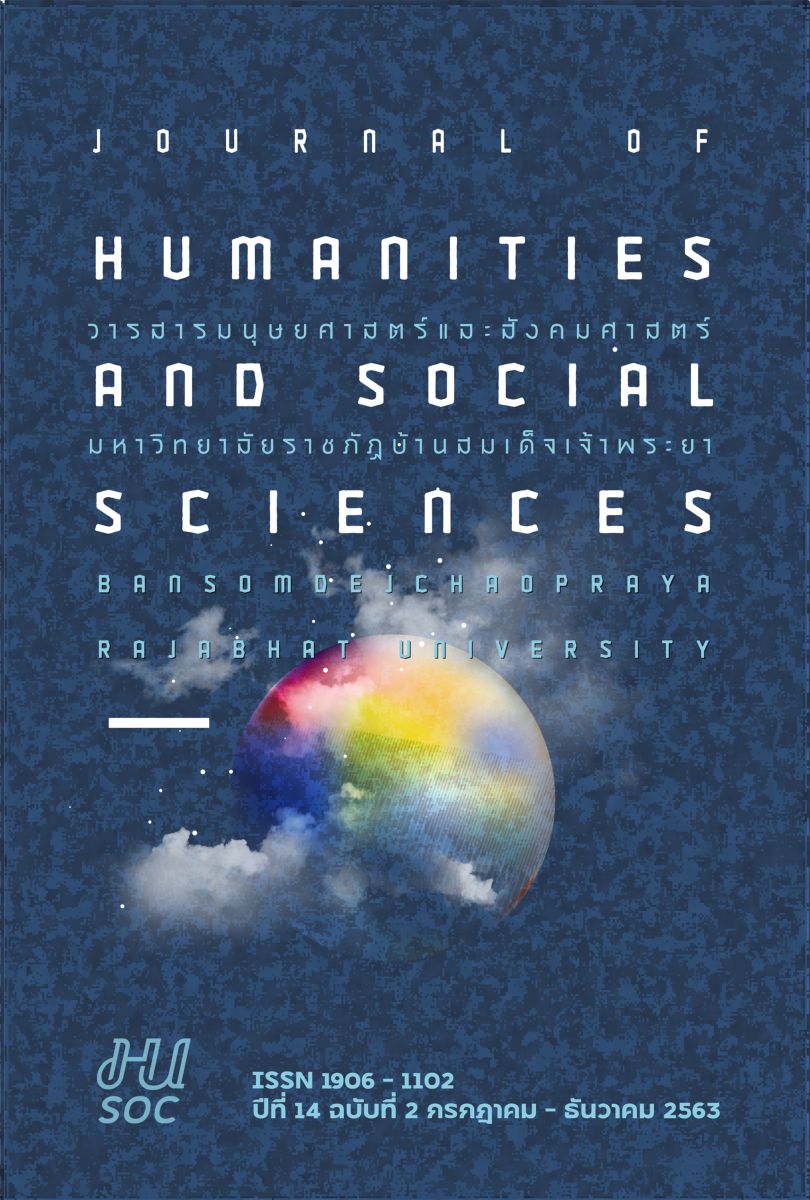การพัฒนารายวิชาวัฒนธรรมอาเซียนกับการออกแบบสำหรับหลักสูตรศิลปกรรมศาสตรบัณฑิต สาขาวิชาออกแบบกราฟิกและอินโฟร์ มหาวิทยาลัยราชภัฏบ้านสมเด็จเจ้าพระยา
คำสำคัญ:
การพัฒนารายวิชา, วัฒนธรรมอาเซียน, การออกแบบหลักสูตรศิลปกรรมศาสตรบัณฑิตบทคัดย่อ
การวิจัยนี้มีวัตถุประสงค์เพื่อพัฒนารายวิชาวัฒนธรรมอาเซียนกับการออกแบบ สำหรับหลักสูตรศิลปกรรมศาสตรบัณฑิต สาขาวิชาออกแบบกราฟิกและอินโฟร์ มหาวิทยาลัยราชภัฏบ้านสมเด็จเจ้าพระยา โดยใช้เทคนิคการวิจัยอนาคตแบบ EDFR กลุ่มตัวอย่างประชากร ได้แก่ ผู้เชี่ยวชาญด้านวัฒนธรรมอาเซียนและด้านการออกแบบ จำนวน 13 คน คัดเลือกแบบเฉพาะเจาะจง เครื่องมือที่ใช้ในการวิจัยและเก็บรวบรวมข้อมูล ได้แก่ รอบที่ 1 เป็นแบบสัมภาษณ์ รอบที่ 2 และ 3 เป็นแบบสอบถาม สถิติที่ใช้ ได้แก่ ค่ามัธยฐาน (Md. ≥ 3.50) และค่าพิสัยระหว่างควอไทล์ (IQR ≤ 1.50) ผลการวิจัยสรุปได้ดังนี้ แนวทางการพัฒนารายวิชาวัฒนธรรมอาเซียนกับการออกแบบที่ครอบคลุมรายละเอียดของรายวิชา (มคอ.3) ใน 4 ประเด็น พบว่า 1) จุดมุ่งหมายและวัตถุประสงค์ กลุ่มผู้เชี่ยวชาญมีความเห็นด้วยโดยรวมอยู่ในระดับมากที่สุดและมีความสอดคล้องกันของคำตอบ 2) การพัฒนาผลการเรียนรู้ของนักศึกษาทั้ง 6 ด้านที่รายวิชาต้องพัฒนา กลุ่มผู้เชี่ยวชาญมีความเห็นด้วยอยู่ในระดับมากถึงมากที่สุดและมีความสอดคล้องกันของคำตอบ โดยใช้วิธีการสอนและการประเมินผลที่หลากหลายเพื่อการพัฒนาทักษะที่จำเป็นในศตวรรษที่ 21 3) แผนการสอนและการประเมินผล กลุ่มผู้เชี่ยวชาญมีความเห็นด้วยโดยรวมอยู่ในระดับมากที่สุดและมีความสอดคล้องกันของคำตอบ และ 4) ทรัพยากรประกอบการเรียนการสอน กลุ่มผู้เชี่ยวชาญมีความเห็นด้วยที่สอดคล้องกันคือการจัดห้องเรียนแบบนั่งเป็นกลุ่ม มีคอมพิวเตอร์เชื่อมต่ออินเทอร์เน็ตเพื่อการสืบค้นและมีตัวอย่างผลงาน หนังสือ รวมถึงจัดแหล่งความรู้ที่เกี่ยวข้อง
เอกสารอ้างอิง
กรมส่งเสริมวัฒนธรรม. (2559). รายงานประจำปี 2559. สืบค้นเมื่อ 2 เมษายน 2560, จาก http://book.culture.go.th/plan/2559/mobile/index.html#p=177.
กุลธิดา สิงห์สี. (2557). อุดมศึกษาไทยในอาเซียน รูปแบบแนวโน้มและทิศทางการปรับตัวในอนาคต. วารสารมหาวิทยาลัยราชภัฏลำปาง, 2(2), 13-23. สืบค้นเมื่อ 15 สิงหาคม 2562, จาก http://so04.tci-thaijo.org/index.php/JLPRU/article/view/24661
กุลนิษก์ สอนวิทย์. (2558, มกราคม – มิถุนายน). การพัฒนารูปแบบการเรียนการสอนโดยใช้กระบวนการเรียนรู้ด้วยทฤษฎีการคิดนอกกรอบของ เดอ โบโน ในวิชาการออกแบบเพื่อพัฒนาความคิดสร้างสรรค์. วารสารครุศาสตร์สาร, 9(2), 39-52.
ขวัญชัย บัวนา, ธารทิพย์ บัวนา และเลเกีย เขียวดี. (2561, มีนาคม – เมษายน). การพัฒนารูปแบบการเรียนการสอนเพื่อส่งเสริมทักษะการเรียนรู้ในศตวรรษที่ 21. วารสารมนุษยศาสตร์และสังคมศาสตร์ มหาวิทยาลัยมหาสารคาม. 37(2), 77-96. สืบค้นเมื่อ 15 สิงหาคม 2562, จาก http://www.journal.msu.ac.th/upload/articles/article2126_41794.pdf
ไพฑูรย์ สินลารัตน์. (2557). หลักและเทคนิคการสอนระดับอุดมศึกษา. (พิมพ์ครั้งที่ 4). กรุงเทพฯ: สนักพิมพ์แห่งจุฬาลงกรณ์มหาวิทยาลัย.
วัชราภรณ์ ทวีกุล, สัญญา เคณาภูมิ และยุภาพร ยุภาศ. (2558, กันยายน – ธันวาคม). บทบาทของมหาวิทยาลัยในกระบวนทัศน์ความเป็นประชาคมอาเซียน. วารสารวิชาการแพรวากาฬสินธุ์, 2(3), 110-129. สืบค้นเมื่อ 2 พฤษภาคม 2562, จาก http://praewa.ksu.ac.th/new2017/file/20170317_6583252545.pdf
สำนักงานเลขาธิการสภาการศึกษา. (2560). แผนการศึกษาแห่งชาติ พ.ศ. 2559-2579. กรุงเทพฯ: พริกหวานกราฟฟิค.
สำนักวัฒนธรรม กีฬา และการท่องเที่ยว กรุงเทพมหานคร. (2557). วัฒนธรรมของประเทศสมาชิกอาเซียน ตามโครงการส่งเสริมองค์ความรู้เกี่ยวกับวัฒนธรรมอาเซียน. กรุงเทพฯ: ม.ป.พ.
อาภรณ์ ใจเที่ยง. (2553). หลักการสอน. (พิมพ์ครั้งที่ 5). กรุงเทพฯ: โอเดียนสโตร์.
ดาวน์โหลด
เผยแพร่แล้ว
รูปแบบการอ้างอิง
ฉบับ
ประเภทบทความ
สัญญาอนุญาต

อนุญาตภายใต้เงื่อนไข Creative Commons Attribution-NonCommercial-NoDerivatives 4.0 International License.




